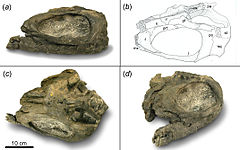Our website is made possible by displaying online advertisements to our visitors.
Please consider supporting us by disabling your ad blocker.
Shastasaurus
Shastasaurus
Crâne de Shastasaurus pacificus (UCMP 9017).
Espèces de rang inférieur
- † S. pacificus Merriam, 1895 (espèce type)
- † ? S. carinthiacus von Huene, 1925
- † ? S. alexandrae
Shastasaurus est un genre éteint de très grands ichthyosaures, des diapsides marins de la famille des Shastasauridae[1],[2]qui vivaient dans ce qui est aujourd'hui l'Amérique du Nord. Il a été découvert en Californie et au Nevada (États-Unis) ainsi qu'au Mexique. Elles ont vécu durant le Trias supérieur, il y a environ entre 237 et 201 Ma (millions d'années).
Trois espèces sont parfois rattachées au genre, S. alexandrae, S. carinthiacus et S. pacificus[3], mais seule Shastasaurus pacificus, l'espèce type, est considérée comme valide.
Plusieurs fossiles d’ichtyosaures, parfois regroupés sous le nom de genre Shastasaurus[4], appartiennent à d'autres genres, comme :
- Guanlingsaurus liangae, ex- Shastasaurus liangae[5] ;
- Shonisaurus sikanniensis, ex-Shastasaurus sikanniensis, connu comme le plus grand ichthyosaure et le plus grand reptiles marins ayant jamais existé avec ses 23 mètres de long et une masse de 20 tonnes[6],[7],[8].
- ↑ (en) C. Ji, D. Y. Jiang, R. Motani, W. C. Hao, Z. Y. Sun et T. Cai, « A new juvenile specimen of Guanlingsaurus (Ichthyosauria, Shastasauridae) from the Upper Triassic of southwestern China », Journal of Vertebrate Paleontology, vol. 33, no 2, , p. 340 (DOI 10.1080/02724634.2013.723082)
- ↑ (en) Ji C, Jiang D-y, Motani R, Rieppel O, Hao W-C, Sun Z-Y. 2016. Phylogeny of the Ichthyopterygia incorporating recent discoveries from South China, Journal of Vertebrate Paleontology. 2016; 36: e1025956
- ↑ (en) http://fossilworks.org/?a=taxonInfo&taxon_no=106733
- ↑ (en) P. Martin Sander, Xiaohong Chen, Long Cheng, Xiaofeng Wang Short-Snouted Toothless Ichthyosaur from China Suggests Late Triassic Diversification of Suction Feeding Ichthyosaurs P. Martin Sander, Xiaohong Chen, Long Cheng, Xiaofeng Wang PLOS x Published: May 23, 2011https://doi.org/10.1371/journal.pone.0019480
- ↑ (en) C. Ji, D.-Y. Jiang, R. Motani, W.-C. Hao, Z.-Y. Sun and T. Cai. 2013. A new juvenile specimen of Guanlingasaurus (Ichthyosauria, Shastasauridae) from the Upper Triassic of southwestern China. Journal of Vertebrate Paleontology 33(2):340-348
- ↑ (en) E. L. Nicholls and M. Manabe. 2004. Giant ichthyosaurs of the Triassic - a new species of Shonisaurus from the Pardonet Formation (Norian: Late Triassic) of British Columbia. Journal of Vertebrate Paleontology 24(4):838-849
- ↑ (en) Hilton, Richard P., Dinosaurs and Other Mesozoic Animals of California, University of California Press, Berkeley 2003 (ISBN 0-520-23315-8), at pages 90-91
- ↑ (en) Lomax DR, De la Salle P, Massare JA, Gallois R (2018) A giant Late Triassic ichthyosaur from the UK and a reinterpretation of the Aust Cliff ‘dinosaurian’ bones. PLoS ONE 13(4): e0194742. https://doi.org/10.1371/journal.pone.0194742
Previous Page Next Page



